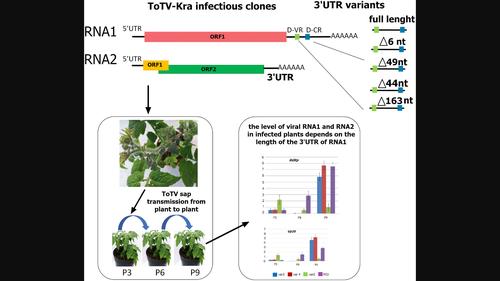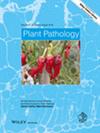番茄torrado病毒(ToTV) RNA1的3′UTR长度影响番茄植株间机械传代过程中病毒的积累
IF 2.4
3区 农林科学
Q1 AGRONOMY
引用次数: 0
摘要
番茄托拉多病毒(ToTV)是托拉多病毒属的一种,主要感染番茄。先前的分析显示,分离物ToTV-Kra的RNA1的3 '非翻译区(3 ' UTR)具有高度异质性。除了全长3 ' UTR RNA1(野生型,wt)外,还鉴定了四个截断版本(var2, var3, var4和var5)。在这里,我们通过评估这些缺陷基因组是否具有传染性,以及3 ' UTR的长度如何影响疾病症状、病毒传播和病毒RNA积累来研究这种现象的生物学重要性。利用tovpjl - kra感染克隆,我们引入了与已知RNA1缺陷变体对应的缺失,并检测了它们对ToTV毒力和液传播能力的影响。病毒RNA的积累是评估在agro浸润番茄,并在连续传代。我们发现所有的缺陷基因组都具有传染性,RNA1的3 ' UTR长度影响病毒RNA的积累。经var2、var3和var5混染的番茄基因组rna拷贝数最高。然而,在连续传代过程中,ToTVpJL-Kra-var1和-var2(短6个核苷酸)与其他变体相比,表现出有限的汁液传播能力,但在番茄中持续存在并复制良好。用ToTVpJL-Kra-var3、-var4和var1-var5的混合物处理的植株显示出最高的病毒RNA积累,与其他变体相比,这与症状严重程度的增加无关。此外,我们在var3 RNA1的3 ' UTR中发现了一个进一步的序列插入。这种插入可能是自发发生的,也可能是病毒适应传播方式的结果。本文章由计算机程序翻译,如有差异,请以英文原文为准。

The length of the 3′ UTR of the tomato torrado virus (ToTV) RNA1 affects virus accumulation in Solanum lycopersicum during mechanical passages from plant to plant
Tomato torrado virus (ToTV), a member of the Torradovirus genus, primarily infects tomatoes. Previous analyses revealed high heterogeneity in the 3′ untranslated region (3′ UTR) of RNA1 of isolate ToTV-Kra. In addition to the full-length 3′ UTR RNA1 (a wild-type, wt), four truncated versions (var2, var3, var4 and var5) were identified. Here, we investigated the biological importance of this phenomenon by assessing whether such defective genomes are infectious individually, and how the length of the 3′ UTR influences disease symptoms, virus transmission and viral RNA accumulation. Using the ToTVpJL-Kra infectious clone, we introduced deletions corresponding to the known RNA1 defective variants and examined their impact on ToTV virulence and sap transmission ability. Viral RNA accumulation was assessed in agroinfiltrated tomatoes, as well as during serial passages. We found that all defective genomes were infectious and the length of the 3′ UTR of RNA1 influenced viral RNA accumulation. Tomatoes agroinfiltrated with var2, var3 or var5 showed the highest copy numbers of genomic RNAs. However, during serial passages, ToTVpJL-Kra-var1 and -var2 (six nucleotides shorter) showed limited sap transmission ability compared to the other variants, which persisted and replicated well in tomatoes. Plants treated with ToTVpJL-Kra-var3, -var4 and a mixture of var1–var5 showed the highest viral RNA accumulation, which was not associated with increased symptom severity in comparison to the other variants. Additionally, we identified a further sequence insertion in the 3′ UTR of var3 RNA1. This insertion could have occurred spontaneously or as a result of virus adaptation to the mode of transmission.
求助全文
通过发布文献求助,成功后即可免费获取论文全文。
去求助
来源期刊

Plant Pathology
生物-农艺学
CiteScore
5.60
自引率
7.40%
发文量
147
审稿时长
3 months
期刊介绍:
This international journal, owned and edited by the British Society for Plant Pathology, covers all aspects of plant pathology and reaches subscribers in 80 countries. Top quality original research papers and critical reviews from around the world cover: diseases of temperate and tropical plants caused by fungi, bacteria, viruses, phytoplasmas and nematodes; physiological, biochemical, molecular, ecological, genetic and economic aspects of plant pathology; disease epidemiology and modelling; disease appraisal and crop loss assessment; and plant disease control and disease-related crop management.
 求助内容:
求助内容: 应助结果提醒方式:
应助结果提醒方式:


